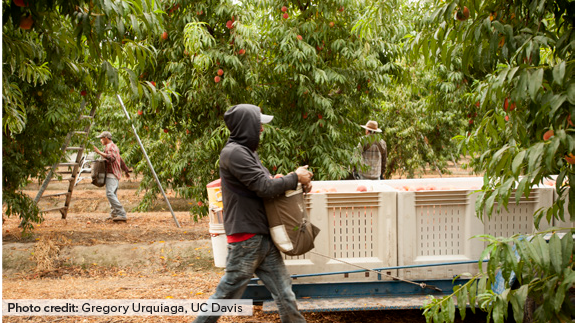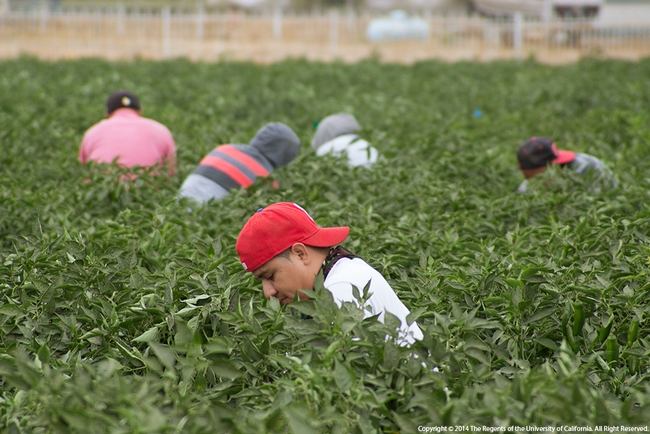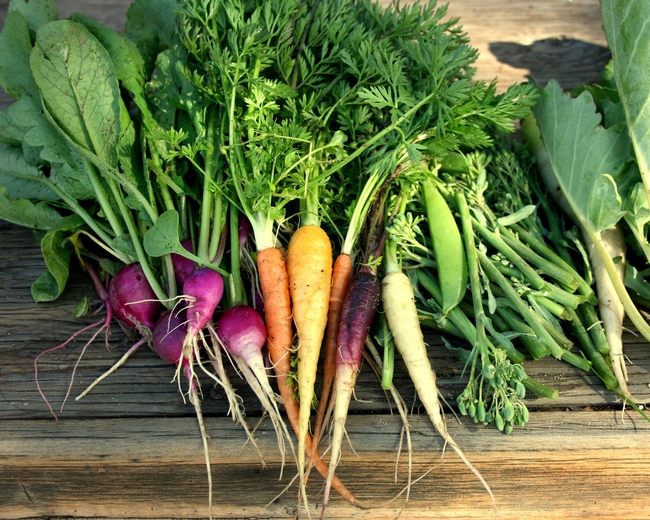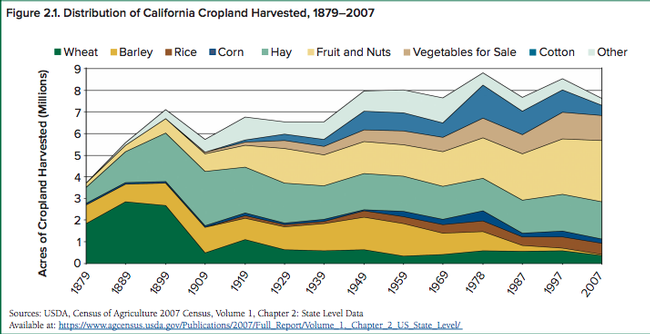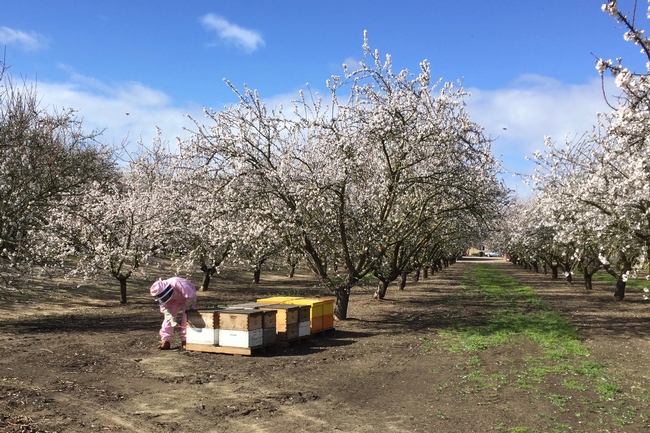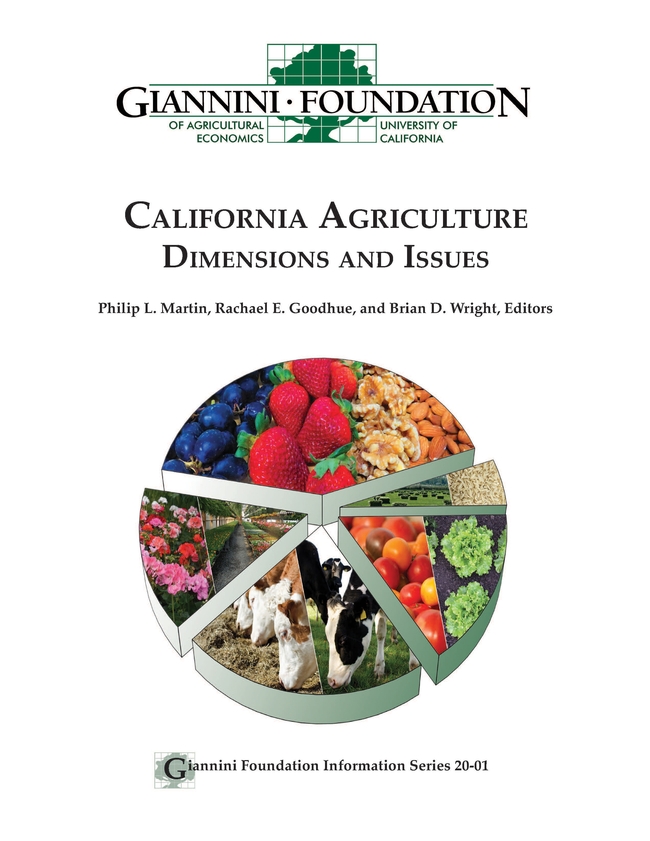Posts Tagged: Giannini Foundation
Did California’s ag overtime law help farmworkers?
After AB 1066, ag workers see average hours, wages fall
Proponents of California's agricultural overtime law, AB 1066, have called it a victory for farmworkers, while critics have asserted that it will harm the very people it was designed to protect. New research by Alexandra Hill, UC Cooperative Extension specialist and assistant professor in UC Berkeley's Department of Agricultural and Resource Economics, shows that, on average, there has been a decrease in worker hours and wages.
Her estimates suggest that in the first two years of its implementation, California's farmworkers worked a total of 15,000 to 45,000 fewer hours and earned a total of $6 million to $9 million less on their weekly paychecks than they would have without this law in place.
In 2016, California passed Assembly Bill 1066, legislation that removed existing overtime exemptions for farmworkers in the Fair Labor Standards Act. The FLSA is the federal law that mandates many employment conditions, including overtime standards. In non-exempt industries, it requires that employers pay 1.5 times an employee's regular pay rate for any hours worked beyond 40 hours per week.
Prior to AB 1066, agricultural workers in California were entitled to overtime pay for hours worked beyond 60 hours per week, but AB 1066 changed this beginning in 2019. The law mandated a gradual phase-in (over four years) of reduced overtime thresholds (lowering the weekly hours threshold by 5 hours/week each year) until agricultural employees are subject to the same overtime standards as workers in other industries (40 hours/week).
Many farmers feared that this new policy would drive food prices up, push them out of business, or force a faster transition to mechanization. Most reported that they would reduce hours for individual workers to remain below the new overtime standards and avoid paying the higher rates.
However, media, advocacy groups, and others heralded the law as a major win for farmworkers, as it would provide workers with more fair compensation for long workweeks. While long-term effects of the law for farmers and farmworkers remain to be seen, Hill's work sheds light on the early effects of the law on worker hours and earnings.
Using worker-reported hours from the National Agricultural Workers Survey both before and in the two years after the law went into effect (2019 and 2020), economist Hill explored the effects of AB 1066. Overall, she finds that worker hours and earnings decreased as an effect of the legislation.
Her work highlights that the share of workers working 56–60 hours/week, just below the old overtime threshold, decreased by roughly half. Most of these workers shifted to working fewer hours; the share working 46–50 hours/week, just below the new (as of 2020) overtime threshold, increased by roughly one-third. She found similar reductions in worker earnings.
The share of the workforce with higher weekly earnings (between $600 and $800/week) decreased by roughly one-third, with most of these workers shifting into a lower earnings bracket of $400–$500/week. These changes in hours and pay are consistent with employers behaving as they claimed they would – by cutting hours to avoid paying overtime rates.
Hill notes that these decreases in average wages and hours may be positive for those who want more leisure time and may – due to shorter workdays and weeks – improve workplace safety. However, she also warns that this can be detrimental for “workers and their families who were depending on this lost income to cover living expenses (and who) may now need to seek out second employment opportunities, negating these other benefits and adding the inconvenience of traveling between jobs.”
To learn more about the effects of AB 1066 on California farmworkers, read the full article by Hill: “California's Overtime Law for Agricultural Workers: What Happened to Worker Hours and Pay?” online at https://giannini.ucop.edu/publications/are-update.
ARE Update is a bimonthly magazine published by the Giannini Foundation of Agricultural Economics to educate policymakers and agribusiness professionals about new research or analysis of important topics in agricultural and resource economics. Articles are written by Giannini Foundation members, including University of California faculty and Cooperative Extension specialists in agricultural and resource economics, and university graduate students. Learn more about the Giannini Foundation and its publications at https://giannini.ucop.edu.
Is inflation here to stay?
If energy price spikes and supply chain disruptions continue, inflation expected to persist
In January 2022, inflation reached its highest yearly increase at 7.5% in nearly 40 years. But are these high rates here to stay, or are they only a temporary symptom of COVID-19 and the recent supply chain-related disruptions?
Economists from UC Davis, Bar-Ilan University, and the London School of Economics analyzed financial markets that trade in the risk of inflation to show how expectations of long-term inflation have changed over the last year. They found that between November 2020 and November 2021, there was over a tenfold increase in the probability of average inflation lying above 3% over the next five years, suggesting that many expect inflation to persist.
Inflation, as measured by the Consumer Price Index (CPI), has risen dramatically over the last year. Gas prices hit a new all-time high in November 2021, with inflation for food at home, electricity, and new vehicles at 6.5%, 6.3%, and 11.8%, respectively, in December. Rising oil and natural gas prices, higher personal savings and increased consumer demand coming out of the lockdown, and a sluggish supply chain coming out of the pandemic may all be partially to blame for inflation over the last year.
As pent-up demand slows and supply chains adapt, their impact on inflation may also subside. But, if the energy price spike in response to the invasion of Ukraine persists and if supply disruptions continue, it could lead consumers to demand higher wages to increase their purchasing power.
“If companies raise prices in response to higher wage demands by workers, leading to further high expectations of inflation, further wage demands, and so on, then the United States could enter the wage-price spiral that is often at the heart of high and persistent inflation,” said Jens Hilscher, associate professor in the Department of Agricultural and Resource Economics at UC Davis.
To better understand the likelihood of long-term inflation, Hilscher and co-authors Alon Raviv, senior lecturer at Bar-Ilan University, and Ricardo Reis, A.W. Phillips Professor of Economics at the London School of Economics, looked to the financial markets that trade in contracts that pay off if inflation rises above a given cutoff (with one cutoff at 3% and another at 4% — both well above the Federal Reserve's target of 2% inflation per year). Assessing the payoffs of these two types of contracts allowed them to determine the probability of the average inflation being above 3% or 4% over the next five years.
They found that between November 2020 and November 2021, the probability of an average inflation of 3% jumped from 6.1% to 66.2%, while the probability of an average inflation of 4% rose from 1.6% to 14.1%, a dramatic increase.
Long-term inflation leads to higher uncertainty, making long-term planning harder for businesses and individuals alike. It also leads to lenders experiencing a loss in the real value of the money they are repaid. Over time, these factors lead lenders to charge higher interest rates to account for uncertainty and potential losses. In turn, access to credit will suffer.
Hilscher noted, “A central bank that is very committed to a stable inflation target can always bring inflation down, even if only by causing a recession. We will see over the next several months which risk the Fed perceives to be the greater threat to our economy.”
To learn more about the risk of long-term inflation, read the full article “Inflation Risks are on the Rise,” by Hilscher, Raviv and Reis published by UC Giannini Foundation of Agricultural Economics in ARE Update 25(3): 9–11, free online at https://giannini.ucop.edu/filer/file/1645718420/20317.
ARE Update is a bimonthly magazine published by the Giannini Foundation of Agricultural Economics to educate policymakers and agribusiness professionals about new research or analysis of important topics in agricultural and resource economics. Articles are written by Giannini Foundation members, including University of California faculty and Cooperative Extension specialists in agricultural and resource economics, and university graduate students. Learn more about the Giannini Foundation and its publications at https://giannini.ucop.edu.
‘Containergeddon’ at ports cost California farmers $2.1 billion in exports
New research estimates economic losses due to congestion, inefficiencies
Between wildfires, drought, a trade war and the COVID-19 pandemic, the last few years have been hard on California farmers. But recent research by agricultural economists from UC Davis and the University of Connecticut suggests that economic losses to California agriculture from recent supply chain disruptions may have an even greater economic impact.
In an article titled “‘Containergeddon' and California Agriculture,” researchers estimate that there was a 17% decline in the value of containerized agricultural exports between May and September 2021, resulting from recent port congestion. This amounts to around $2.1 billion in lost foreign sales, which exceeds losses from the 2018 U.S.-China trade war.
By the peak of the disruption in September 2021, nearly 80% of all containers leaving California ports were empty – about 43% fewer filled containers leaving California's ports than there were prior to the pandemic. And since 40% of filled shipping containers leaving California's ports are filled with U.S. agricultural products – around a third of which are from California – farmers in the state experienced significant lost export opportunities.
By September 2021, there were around 25,000 fewer containers filled with agricultural products leaving California ports than there were in May 2021. Processed tomatoes, rice, wine and tree nuts saw the sharpest average trade declines.
“We calculated California tree nut producers lost about $520 million,” said Colin Carter, UC Davis Distinguished Professor of agricultural and resource economics. “This was followed by wine with a loss of more than $250 million and rice with about $120 million lost.”
During the pandemic, an increase in household savings led to increases in consumer spending, with many of these additional goods being imported from Asia. California ports were overwhelmed by the added shipping containers coming in from Asia. At times, bottlenecks at Southern California ports left more than 80 vessels waiting off the coast to unload. Docks and warehouses ran out of space and the turnaround time for shipping containers nearly doubled.
Increased U.S. demand for imported goods from Asia also led to increased demand for empty shipping containers in Asia. Prior to the pandemic, freight rates for shipping containers from Shanghai to Los Angeles were already higher than the return trip from Los Angeles, but this gap widened significantly after COVID-19. By September 2021, the fee to ship a 40-foot container from Shanghai to Los Angeles had increased sixfold to $12,000 – while the return trip from Los Angeles was only $1,400.
The high prices for containers from Asia, coupled with shipping delays from the high volume of imported goods entering California ports, made it more profitable for shippers to return containers to Asia empty, rather than waiting at the ports to have them loaded with U.S. exports for the return trip.
“If port inefficiencies persist, the ramifications for California agriculture will extend beyond the immediate loss of foreign sales, as importers begin to view California as an unreliable supplier of agricultural products,” Carter said.
To learn more about the supply chain disruptions at California ports, and their effect on California agriculture, read the full article by Colin Carter (Distinguished Professor in the Department of Agricultural and Resource Economics at UC Davis), Sandro Steinbach, and Xiting Zhuang (assistant professor and Ph.D. student, respectively, both in the Department of Agricultural and Resource Economics at the University of Connecticut): “‘Containergeddon' and California Agriculture,” ARE Update 25(2): 1–4. UC Giannini Foundation of Agricultural Economics, online at https://giannini.ucop.edu/filer/file/1640021835/20297/.
ARE Update is a bimonthly magazine published by the Giannini Foundation of Agricultural Economics to educate policymakers and agribusiness professionals about new research or analysis of important topics in agricultural and resource economics. Articles are written by Giannini Foundation members, including University of California faculty and Cooperative Extension specialists in agricultural and resource economics, and university graduate students. Learn more about the Giannini Foundation and its publications at https://giannini.ucop.edu/.
Will California remain leader in U.S. agricultural production?
"California Agriculture: Dimensions and Issues" by the Giannini Foundation of Agricultural Economics details the past, present and future of many of California's major agricultural commodities, including grapes, tree fruits and nuts, vegetable crops, dairy, livestock, nursery and floral production, and cannabis. The new 18-chapter book, written by agricultural economists at UC Davis, UC Berkeley and UC Riverside, addresses issues such as labor, water, climate and trade that affect all of California agriculture.
"California agriculture overcame many obstacles to become the nation's number one farm state. Leading agricultural economists are generally optimistic that California agriculture will continue to thrive in the 21st century, despite continuing large challenges," said Philip Martin, UC Davis emeritus professor of agricultural and resource economics, who is co-editor of the new publication.
For over 70 years, California has led the nation in farm sales due to its specialization in high-value commodities such as fruits, nuts, vegetables and other horticultural crops. The book uses the most recent Census of Agriculture data to show that, of the $64 billion of these crops produced in the U.S. in 2017, California produced nearly half by value ($31 billion).
More than 44 percent of California's $50 billion in farm sales in 2017 were fruits and nuts, with 17 percent of sales from vegetables and melons, and 14 percent from nursery and other horticultural specialties crops. Many of these high-value specialty crops are also very labor-intensive and face challenges from increased cost and decreased availability of agricultural labor. The book discusses how California growers effectively responded to these labor challenges by adopting labor-saving mechanization. California remains competitive with producers elsewhere by relying on superior plant varieties, integrated pest management, and improved irrigation methods that increase both the quantity and quality of California agricultural commodities.
Water, climate and trade pose challenges and opportunities for California agriculture. In the last decade, water scarcity and decreased water quality, along with regulations to address these issues like the Sustainable Groundwater Management Act, have prompted farmers to use scarce water to irrigate more valuable crops, as with the switch from cotton to almonds. Increased regulations and the increasing scarcity of water affect high-value specialty crops as well as the dairy and livestock industries that accounted for 24% of California farm sales in 2017.
Climate variability, including drought and heat stress, affects farmworker welfare, crop yields and dairy productivity. Retaliatory tariffs resulting from the 2018 trade war reduced U.S. agricultural exports to China by close to $14.4 billion per year, as exports of dairy, livestock and specialty crops fell.
California agriculture has a rich history of overcoming challenges by pursuing innovative research, adopting new technologies, and adapting to changing conditions. Learning how California agriculture has succeeded in the past suggests that the state can maintain its dominant role as an agricultural producer in the future.
Learn more about several of the major California agricultural commodities and the issues and opportunities they face in this new, second edition of California Agriculture: Dimensions and Issues. Read the book for free online as part of the Giannini Foundation's Information Series (20-01) at https://giannini.ucop.edu/publications/cal-ag-book/. A paperback copy of the 414-page book can be ordered for $55 at http://bit.ly/CalAgBook2ndEd.
The Giannini Foundation was founded in 1930 from a grant made by the Bancitaly Corporation (later renamed Bank of America) to the University of California. Its mission is to promote and support research and outreach activities in agricultural economics and rural development to benefit the agricultural industry, policymakers, and society at large. Giannini members include University of California faculty and Cooperative Extension Specialists in agricultural and resource economics. Learn more about the Giannini Foundation of Agricultural Economics at https://giannini.ucop.edu.
Kenneth R. Farrell, former UC ANR vice president, dies
Kenneth R. Farrell, former University of California vice president for Agriculture and Natural Resources, died following a brief illness in Walnut Creek, Calif., on Jan. 24. He was 87.
Farrell was born Jan. 17, 1927, in South Mountain, Ontario, Canada, and grew up on a small farm. After graduating high school, he became a high school teacher in a one-room school in Ontario. He went on to enroll in college at the University of Toronto–Ontario Agricultural College at Guelph, where he earned a bachelor's degree in agricultural economics. He later earned his master's degree and Ph.D., both in agricultural economics, from Iowa State University.
In 1957, Farrell joined UC Cooperative Extension, working on agricultural marketing and agricultural policy with the Giannini Foundation at UC Berkeley. He also undertook a variety of administrative assignments focused on strengthening Cooperative Extension. His work was punctuated the following decade by a year's study at the University of Naples (Italy) on a Fulbright Fellowship and several short-term assignments with the U.S. Department of Agriculture.
He left UC in 1971 to head the USDA Economic Research Service in Washington, D.C. In 1981, he left federal service to found the National Center for Food and Agricultural Policy at Resources for the Future in Washington, D.C. Funded by the Kellogg, Ford and Rockefeller Foundations, the center was a first-of-its-kind independent, nonpartisan group devoted to the analysis of national agricultural and natural resource policy issues.
In his role as a UC vice president from 1987 to 1995, Farrell oversaw the Agricultural Experiment Station, located on the Berkeley, Davis and Riverside campuses, and Cooperative Extension, located statewide in California counties.
“Ken Farrell was a person of rare integrity and courage,” said Henry Vaux, Jr., who served as associate vice president to Farrell. “His successful efforts to decentralize Cooperative Extension and to make the research and outreach activities of the Division of Agriculture and Natural Resources more seamless benefited California's citizens and its agricultural sector enormously. His leadership proved crucial in positioning the Division to remain effective in the subsequent era of declining resources.”
Over the course of his career he authored more than 100 professional papers and articles on his work in agricultural policy, natural resources, international trade and marketing. He received many honors, including elections as president of the Agricultural and Applied Economics Association in 1977 and as fellow in 1980. In 1992 he was elected fellow of the American Association for the Advancement of Science, and in 2004 his undergraduate alma mater, the University of Guelph–Ontario Agricultural College, established the Kenneth R. Farrell Distinguished Public Policy Lectureship in his honor.
“Ken was a leader among his peers. He always stood his ground,” said Gordon Rausser, Robert Gordon Sproul Distinguished Professor of Agricultural and Resource Economics and former dean of the College of Natural Resources at UC Berkeley.
In retirement, Farrell consulted for the U.S. Department of Agriculture and the World Bank, assignments that took him to Armenia, Georgia and Azerbaijan. He also organized “People-to-People” trips to study agriculture in Cuba, Peru, Chile, Australia and New Zealand, and two such trips to China.
Farrell's wife of over 60 years, Mary, preceded him in death in 2013. He is survived by six children, eight grandchildren and three great-grandchildren.
A memorial gathering in honor of Farrell will be held at Creekside Clubhouse, 1010 Stanley Dollar Drive, Rossmoor, Walnut Creek, at 3 p.m. on Saturday, March 8. In lieu of flowers, the family asks that donations be made to Heifer International (http://www.heifer.org), a charity focused on ending hunger and poverty and promoting food security, or to a charity of choice.

